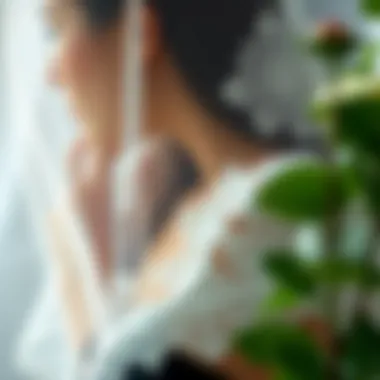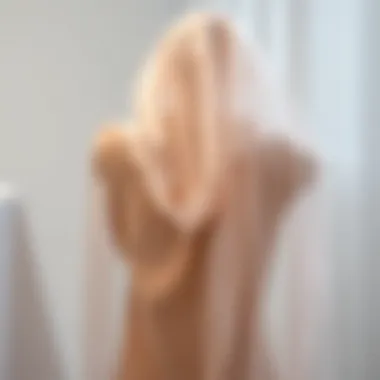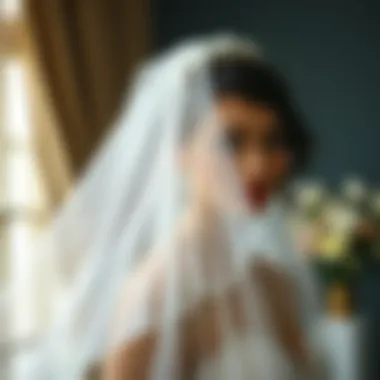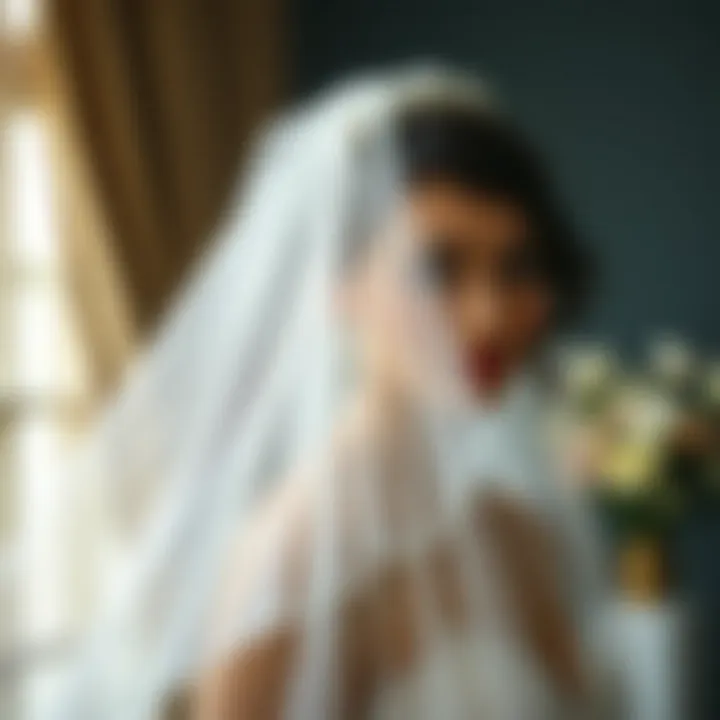Comprehensive Guide to Buying Veils: Styles and Significance


Intro
Exploring the realm of veils goes beyond simple fabric choices. Whether for a wedding, ceremonial purpose, or personal expression, veils carry significant meaning and serve various functions across cultures. Understanding this multidimensional aspect can empower buyers to make choices that resonate with their personal taste and cultural background.
This guide will navigate the landscape of veil purchasing, addressing significant elements such as styles, materials, and cultural interpretations. From historical influences to modern trends, this article will arm you with knowledge to make an informed decision when buying a veil.
As you embark on this journey, consider not only what your veil looks like, but also the stories it tells and the traditions it embodies.
You might find yourself caught between delicate chiffon and ornate lace, both of which offer different vibes and meanings. Thus, grasping these details will lead to a purchase that feels authentic and purposeful.
With that in mind, let’s dive into the diverse world of veils, starting with understanding their fundamental types, then looking into various materials and what current styles are trending.
Understanding Veils
The world of veils can be as intricate as a lace design itself. Understanding veils is not just about the fabric or style you choose; it involves grasping the cultural, historical, and personal significance behind them. A veil can represent many things: purity, tradition, or even a spark of fashion flair. It’s crucial to take time to explore these layers, which, much like the fabric, are woven together to create a complete picture.
There are several important elements to consider regarding veils. First, the historical context can provide insight into why certain styles emerged and how they have evolved over time. This helps to deepen one’s appreciation of the art of veiling, giving buyers a rich narrative to accompany their choice. On the other hand, cultural significance is paramount, as a veil often carries meanings that extend beyond personal aesthetics. These meanings can connect you to traditions and beliefs, shaping your decision in a nuanced way.
Moreover, understanding veils means paying attention to modern interpretations and trends. With styles constantly evolving, what’s in vogue today might take a back seat tomorrow. So, being informed can keep one’s choices fresh and relevant.
In the end, knowing the ins and outs of veils equips buyers with the knowledge necessary to make informed choices that reflect not only their own style but also an awareness of the deeper stories and meanings the veil can convey.
Historical Context
Origins of the Veil
The origins of the veil trace back to ancient civilizations where it was used for practical and symbolic purposes. In many cultures, veils served not only as modesty garments but also as status symbols. For instance, in ancient Rome, women of higher social standing wore veils to visually signal their status and virtue. This attribute remains a focal point today.
The key characteristic of the veil's origin is its multifaceted role across societies. By understanding this background, one can appreciate the depth of meaning behind any veil purchased. Today, bridal veils still echo these archaic practices, symbolizing purity and a commitment to tradition. However, they can also spark a personal connection. Choosing a veil that resonates with this deep-rooted tradition can evoke a sense of belonging and continuity in a rapidly changing world.
Noteworthy is how prices vary depending on materials and design complexity. A silk veil, with its historical roots, may come at a premium, but its luxurious texture and timeless appearance make it a worthwhile investment. However, some might find it less practical in casual settings, which is a consideration for buyers looking for versatility.
Evolution of Veil Styles
As fashion carries the narrative through time, veil styles have evolved significantly. From the lace-draped structures of the Victorian age to the minimalistic outlines favored today, the transformation speaks volumes about changing societal values. The evolution of veil styles reveals a constant interplay between individual expression and cultural norms, showcasing how veils adapt to contemporary tastes.
The key aspect of veil evolution lies in how designs reflect societal shifts. In recent years, there’s been a surge of popularity for bohemian styles, emphasizing personalization rather than conformity to strict traditions. This variety allows individuals to express their unique identity through their choice of veil.
There are both advantages and disadvantages regarding these evolving styles. On the one hand, modern designs offer a refreshing break from traditional constraints, encouraging creativity. On the other hand, the vast array of choices can make it daunting for buyers to decide. Feeling overwhelmed is common in such a rich tapestry of options, so buyers should always take the time to reflect on what they truly value in a veil.
Cultural Significance
Veils in Religious Practices
Within many faiths, veils carry an essential cultural weight, often wrapped in and around beliefs about modesty, purity, and spirituality. In Islamic traditions, for instance, wearing the hijab signifies a commitment to faith and personal values. It is about more than just a piece of cloth; it symbolizes a way of life and connection to a higher purpose.
The key characteristic of veils in religious contexts is how they invoke respect and honor. For religious adherence, selecting a veil that aligns with one’s beliefs can be a powerful and intentional choice. This connection inspires not just a look but encapsulates deeper meanings and ideals.
However, there is also a potential downside. Misunderstandings or cultural appropriation can arise, particularly in diverse societies. Thus, it is vital for individuals to approach these veils with sensitivity and a desire to truly comprehend their significance.
Symbolism Across Cultures
The symbolism carried by veils can vary significantly from culture to culture. In some, the veil represents purity and chastity, while in others, it stands for mystery or femininity—sometimes being used in performances or art as a tool to evoke emotion or intrigue. This rich symbolism translates the veil into a powerful visual statement, much like a canvas can tell stories through paint.
One notable characteristic of veils is their ability to bridge cultural divides. In an increasingly globalized world, wearing a veil from another culture can celebrate diversity and foster appreciation among different communities. Choosing a veil for its symbolic representation is a way for individuals to connect with various narratives, enriching their understanding.
Still, like all cultural expressions, one must tread lightly. It’s essential for buyers to educate themselves on the stories behind the veils they select, avoiding superficial choices that strip away the rich history encapsulated within these fabrications.
"A veil is not just an accessory; it is a connection to tradition, culture, and self-expression that goes beyond its material form."
Types of Veils
Understanding the various types of veils is crucial in the process of selection, whether for a wedding, a fashion event, or a religious observance. Each category serves its own distinct purpose and reflects different cultural nuances and personal styles. Selecting the right type of veil can enhance the overall aesthetic, complementing not just attire but also resonating with specific traditions and values.
Bridal Veils
Bridal veils are perhaps the most well-known category, traditionally worn by brides during the wedding ceremony. These veils have deep roots in both cultural and religious practices, often signifying purity and modesty. They are available in numerous styles, lengths, and materials.
Catholic vs. Secular Styles
When it comes to bridal veils, one can clearly distinguish between Catholic and secular styles. The Catholic tradition often leans towards more formal and ornate designs, such as the elbow-length or cathedral veils. These veils are typically adorned with lace or embroidery, symbolizing the sacred nature of the marital ceremony. On the other hand, secular styles tend to vary widely, showcasing a broader range of creativity. These veils may include minimalist designs, or ones that incorporate bold colors and unique embellishments. Such diversity allows brides to express their personality while still connecting with wedding traditions. However, one must consider how these choices affect the overall vibe of the ceremony. The Catholic veil may carry emotional weight for some, while the secular style offers more freedom for personal expression.
Length and Fabric Choices


Length and fabric are key elements when choosing a bridal veil. Veils can be lengthy, reaching all the way to the floor, or short, just covering the face. Each serves a role in enhancing the overall bridal aesthetic. Longer veils tend to create a dramatic effect, while shorter options can provide a more modern or casual look. As for fabric, the traditional silk and tulle remain popular, each offering different draping qualities. Silk is luxurious but can be costly, while tulle is lighter and easier to maintain. There’s also the consideration of layering; wearing multiple veils of different lengths can add depth to the wedding look. Ultimately, the choice of length and fabric not just complements the dress, but also sets the tone for the event.
Fashion Veils
Fashion veils are increasingly becoming a statement piece in contemporary attire. As designers innovate, the definition of fashion veils is expanding, integrating trends from the broader fashion landscape.
Trends in Fashion
Keeping up with trends in fashion veils is essential for those wanting to make a unique statement. Currently, vintage-inspired designs are making waves, praised for their romantic aura. Lace, intricate stitching, and various textures evoke nostalgia while lending a sophisticated touch. Conversely, a minimalist aesthetic with clear lines and simple fabrics is favored by many modern designers, offering a fresh, clean slate for embellishments. Such varied styles present the chance for personal expression, yet one must also consider how these trends play out in practical settings. Trending looks can be captivating, but there’s always a risk that they may not age well.
Contemporary Designers
The impact of contemporary designers on the veil market cannot be understated. With an emphasis on personalization and unique craftsmanship, these designers take risks that traditional styles might overlook. Many now offer custom orders where brides can collaborate to create a veil that is distinctly theirs. These bespoke designs often include unexpected elements such as beading, feathers, or even artistic prints that resonate with the wearer's personal narrative. While working with contemporary designers can yield a stunning product, it’s wise to weigh the costs and timelines involved, as custom work can sometimes become a logistical challenge as well.
Religious Veils
Religious veils hold significant meaning in various faiths. They are not just accessories; they hold cultural, historical, and spiritual value.
Types by Faith
In discussing types by faith, it's fascinating to see how different religions utilize veils. In Islam, for example, the hijab serves both cultural identity and religious obligations, promoting modesty. In Christianity, women may wear head coverings in specific church settings, often interpreted as signs of respect and tradition. Each of these styles — from the elaborate, embroidered shawls to simple wraps — offers insight into the beliefs and values of that faith community. Choosing a religious veil is often about more than personal preference; it can symbolize a commitment to one’s beliefs and cultural identity too.
Variations in Design
Design variations among religious veils reflect a multitude of interpretations and cultural influences. For instance, the Islamic hijab can vary from region to region, adapting local textiles and embroidery styles. Meanwhile, in Jewish traditions, the tallit serves as a prayer shawl that may also cover the head and is richly symbolic. By understanding these variations, wearers can make informed decisions that honor both their faith and their personal style. However, it’s important to note that while variety presents choices, it can also lead to confusion for those new to these customs. A respectful approach, combined with adequate knowledge, will lead to a more meaningful choice.
Materials Used in Veils
When diving into the realm of veils, understanding the various materials used is crucial. The fabric and construction not only affect the overall aesthetic but also contribute to the wearability and durability of the veil. Factors such as texture, weight, and breathability should not be overlooked when making a choice. It influences everything, from the drape to how the material interacts with light. So, whether you’re purchasing for a wedding, religious ceremony, or fashion statement, knowing about the fabrics can vastly improve your decision-making process.
Traditional Fabrics
Silk and Tulle
Silk and tulle are two classic choices that have stood the test of time. Silk, often associated with luxury, has a natural sheen and smoothness that many find appealing. Its light weight combined with its strength creates a veil that flows beautifully. On the other hand, tulle is a stiffer fabric, often used to create volume and structure. The charm of tulle is its ethereal quality, allowing it to gently catch the breeze without being overwhelming.
- Key characteristic: The silk's luster and tulle's airy feel.
- Advantages: Silk gives an elegant and high-end appearance, while tulle offers versatility and can be layered or gathered for a more dramatic look.
- Disadvantages: Silk can snag easily and requires careful handling, whereas tulle, though durable, may fray if not protected properly.
Ultimately, choosing something between silk and tulle depends on personal desire and the endpoint use of the veil.
Organza and Lace
Organza, a heavier fabric than tulle but lighter than silk, brings a slightly crispy texture that can add depth to the veil’s overall look. Lace, with its intricate patterns, offers a vintage flair that many brides appreciate for its romanticism. The combination of these two fabrics can create stunning designs, particularly when layered.
- Key characteristic: The craftsmanship of lace versus the modern crispness of organza.
- Advantages: Lace adds an element of detail, while organza retains structure, ideal for voluminous designs.
- Disadvantages: Lace can be more delicate, requiring careful maintenance, and organza may lack some of the softness many expect from veil materials.
These materials can serve different purposes and styles, depending much on the event and the flair desired by the wearer.
Modern Innovations
Synthetic Materials
Synthetic materials, like polyester and nylon, have become increasingly popular in recent years. They offer a range of benefits that natural fibers may not, including affordability and durability. Polyester, for example, mimics the look of silk or tulle but comes at a fraction of the price and is less likely to wrinkle or stain, making it a smart choice for events where longevity is a concern.
- Key characteristic: Cost-efficiency and resilience.
- Advantages: These materials are easier to clean and maintain, appealing for users who want something less finicky.
- Disadvantages: They might lack the luxurious feel or breathability of natural fibers, potentially leading to comfort issues in hot weather.
Sustainable Options
In today’s world, sustainable options are making their mark. Fabrics made from recycled materials or innovative textiles are gaining traction. Organic cotton and economically-conscious silk are examples of eco-friendly alternatives. These materials often provide the same aesthetic charm as their traditional counterparts, but with the added bonus of being gentle on the environment.
- Key characteristic: Eco-friendly nature and responsible sourcing.
- Advantages: They appeal not just to the environmentally-conscious consumer but also offer peace of mind regarding the origins and impact of their purchase.
- Disadvantages: The availability of these options can be somewhat limited depending on location and retailer.
As sustainability takes center stage in many industries, including fashion, investing in such materials could be a forward-thinking choice that aligns with personal values while still achieving the desired style.
Understanding the materials used in veils enhances the ability to select the perfect option. It allows individuals to consider not just aesthetics but also comfort and ethical implications.
Shopping Considerations
When it comes to purchasing veils, the decisions that you make can carry a lot of weight. It's not merely about picking something that looks pretty; rather, each choice is steeped in personal significance, cultural importance, and even practicalities. Understanding this helps buyers navigate the complex landscape of veils more effectively. An informed approach to shopping can save time, avoid buyer's regret, and lead to a veil that truly resonates with your style and sentimental values.
Determining Your Needs


Event Type Consideration
The type of event for which you're buying a veil is perhaps the most important factor to consider. Different occasions have their own nuances and cultural expectations that can dictate your choice. For instance, a bridal veil typically has certain traditional associations and standards—length, material, and style vary from one wedding to the next. If you’re attending a formal ceremony, the choice often leans towards more elaborate and luxurious fabrics.
A unique feature of event type consideration is that it narrows down your options significantly. Knowing that you're shopping for a religious service, for example, might steer you away from ostentatious designs, favoring something more reserved instead. But don't just think of constraints; this consideration ultimately works in your favor. You avoid the risk of selecting something that's not appropriate for the occasion. Plus, it can contribute tremendously to the overall theme and feel of the event.
Overall, aligning your veil with the type of event is a savvy choice—it showcases respect for the occasion while allowing your personality to shine through.
Style Preferences
Next, we have style preferences, which can be quite subjective. They encompass personal tastes and the aesthetic you want to convey. Are you drawn to romantic, vintage-style veils, or do contemporary minimalist looks speak to you? Knowing your style can make a daunting shopping experience feel manageable.
The key characteristic of style preferences is individual expression. It's your way of enhancing your outfit and encapsulating your personality in an accessory. Selecting a veil that resonates with your personal style indeed makes it a special piece, one that captures memories of the moment.
One unique aspect of style preferences is the potential for blending trends or even breaking boundaries. You might choose to mix a bohemian lace veil with a classic wedding gown for an eclectic vibe. While this allows for creativity, it can also be a double-edged sword; the risk of clashing styles exists. Therefore, investing time in understanding what complements your attire while adding to your overall look can be beneficial in crafting the perfect ensemble.
Budgeting for Your Purchase
Understanding Price Ranges
Money matters, as the saying goes, and budgeting for your veil purchase is no exception. Price ranges can vary widely based on several factors such as material, complexity of design, and brand reputation. A delicate handmade veil from a local artisan might fetch a higher price compared to a mass-produced one from a large retailer.
Being aware of these price ranges allows you to set a realistic budget. This prevents the heart-wrenching scenario of falling in love with a veil that your wallet simply cannot accommodate. Understanding what typical costs look like in the veil market equips you with confidence while shopping, helping you knowing exactly how to make your dollars stretch without compromising on quality.
Quality vs. Cost
This leads us straight into the age-old debate: quality versus cost. It’s tempting to opt for the cheaper option, but this may not always be in your best interest. A vale that feels good and looks beautiful is usually worth the investment. After all, veils often become cherished keepsakes, and buying poorly made ones might leave you with regrets down the line.
Quality can be characterized by material durability, craftsmanship, and the intricate details of design. A well-constructed veil can withstand the test of time, whereas a poorly made one might fray or lose its charm after just a few uses. So, while it might sting a little to spend more upfront, the long-term value can be substantial.
Where to Buy a Veil
Physical Stores vs. Online Retailers
When it comes to purchasing veils, choosing between physical stores and online retailers can be tricky. Physical stores allow you to see and feel the veil, providing an opportunity to assess the quality and fit firsthand. Browsing through various designs and speaking directly to knowledgeable staff can aid the decision-making process.
On the flip side, online retailers often provide a broader range of options, including prices that could be more budget-friendly for you. There’s a certain convenience in shopping from home, where you can explore numerous stores in minutes. But then, that comes with the risk of misjudging colors, fabrics, and sizes without trying them on. Each choice has its merits and drawbacks, so understanding what’s vital to you can guide that decision.
Benefits of Custom Orders
Custom orders can be a game changer when it comes to purchasing a veil. Here’s where personal touches enter the equation. They allow for unique designs tailored to your specifications, thus giving you the control to choose the fabric, color, and overall look. What you develop can not only speak to your personal or cultural identity but also ensure a more fitting accessory.
One of the benefits of custom ordering is that it eliminates the compromise often faced in off-the-rack options. These veils can end up being one-of-a-kind treasures, holding significant sentimental value. That said, custom orders usually come with a longer wait time and often a higher price point. So if you go down this route, it’s important to plan ahead.
In summary, thorough shopping considerations will play a pivotal role in making informed and satisfying purchases of veils that reflect both personal desires and situational appropriateness.
Current Trends in Veil Fashion
Exploring the latest trends in veil fashion is essential for anyone considering a purchase. Not only do these trends reflect the current cultural climate, but they also offer insights into what styles resonate with contemporary brides and fashion enthusiasts. By understanding these trends, individuals can make informed decisions that embrace personal taste while keeping an eye on what's en vogue. Whether one leans towards timeless elegance or modern statement pieces, knowing the current landscape can influence choices in style, color, and embellishment.
Popular Styles
Vintage Inspirations
Vintage inspirations in veil styles have made a significant comeback. This style draws heavily from eras such as the 1920s or '50s, with elements like lace, intricate beadwork, and retro silhouettes. A key characteristic of vintage veils is their ability to evoke nostalgia while still feeling fresh. They often carry a romantic quality that appeals to those desiring a timeless look.
One popular choice within this realm is the birdcage veil, which offers a distinct, retro flair. Its unique feature—a short, net-like structure that elegantly covers the face—adds an unexpected touch to modern weddings. While vintage styles are popular, they can present challenges: finding authentic materials sometimes proves tougher than expected, and integrating these styles in a modern setting may require careful thought to avoid clashes with other contemporary elements. Yet, for those seeking to blend the past with present-day narratives, vintage veils are an advantageous choice.
Minimalist Aesthetic
On the flip side, the minimalist aesthetic has gained traction in recent years. This trend emphasizes simplicity and clean lines, focusing on classic designs that leave a lasting impression without overwhelming the viewer. The hallmark of minimalist veils often lies in their sleek forms made from soft fabrics that flow effortlessly, such as silk or tulle.
Why choose minimalist? It's all about the elegance of simplicity. A basic yet refined veil not only complements a wide range of bridal outfits, but it also allows the innate beauty of the wearer to shine through. However, some may argue that the lack of embellishments can make minimalist veils less memorable. Balancing simplicity with unique design choices can enhance their appeal, giving brides a chic yet understated option that celebrates their individuality without overdoing it.
Color and Design Innovations
Non-Traditional Colors
Gone are the days when white was the only color choice for veils. The rise of non-traditional colors has transformed the veil market, introducing shades like blush, deep blue, and even black into the mix. This shift speaks to a more personalized approach to bridal fashion, letting individuals express their unique identities instead of adhering strictly to customs.
One standout trait of non-traditional colors is how they can complement or contrast a wedding dress, enhancing the overall aesthetic of the ensemble. Brides can leverage these colors to tell a story about their backgrounds or personal style, which is a compelling reason for their growing popularity. However, it's worth noting that while these bold choices can stand out, they might not appeal to those who prioritize classic elegance, potentially risking the timeless quality of their looks. Still, for trendsetters, non-traditional colors are a worthwhile avenue to explore.


Personalized Embellishments
Lastly, personalized embellishments continue to gain traction, allowing brides to tailor their veils uniquely. This can range from custom embroidery featuring initials or dates to the addition of crystals or flowers that echo the wedding's theme. The critical characteristic here is the intimacy that comes with personalization—each veil becomes a unique piece of art, resonating deeply with the wearer.
The unique feature of personalized embellishments is their capacity to transform a standard veil into a treasured heirloom that reflects personal stories and relationships. Though some may find that these additions could distract from the veil itself if not executed thoughtfully, the overall benefits are immense. They allow for creativity and individuality that can make every bridal moment feel special and memorable.
"In the world of veils, current trends are not just about what's in style; they're about expressing personal narratives that resonate with the heart."
Exploring these dynamic trends helps brides—and anyone else considering veils—come to terms with what resonates. Knowing what's trending provides a robust backdrop for making choices that blend tradition with modernity, ultimately creating something that not only looks stunning but also feels inherently personal.
Caring for Your Veil
Caring for a veil is vital to ensuring its beauty and longevity. Given that veils often hold sentimental value and can be a cornerstone of a celebratory outfit, neglecting proper maintenance can lead to deterioration that diminishes its charm. The process of cleaning, storing, and restoring your veil involves specific techniques and considerations that significantly enhance its lifespan. Regardless of its fabric, a little careful handling can make a world of difference.
Cleaning Techniques
Hand Washing vs. Professional Care
When it comes to maintaining the pristine appearance of your veil, the debate about hand washing versus professional care is quite telling. Hand washing allows for a more personal touch, giving you control over the water temperature and the gentleness of handling. This method is often recommended for delicate fabrics like silk or lace, as it minimizes the risk of damage found in harsher machine washes. However, it’s essential to use mild detergent and avoid excessive rubbing, which can lead to wear.
In contrast, professional cleaning services can be an appealing choice when dealing with intricate designs or embellishments. Experts are trained to handle delicate materials with specialized solutions, ensuring that even the most fragile veils come back looking as good as new. The downside, of course, is the cost and the potential wait time for repairs or cleaning. Either way, understanding the specific needs of your veil is crucial to preserving its beauty.
Storage Tips
Proper storage can extend the life of your veil beyond simple cleaning. The key here is to store your veil in a cool, dark place, away from direct sunlight, which can lead to fading. A breathable cotton bag can work wonders, as it protects the veil from dust without trapping moisture, which can cause mildew.
The unique feature in storing veils is ensuring that they are laid flat rather than folded. This prevents creases and keeps the fabric smooth. If folding is necessary, use acid-free tissue paper between folds. By taking these simple steps, you enhance the longevity of your veil and keep its beauty intact for years to come.
Restoration Methods
Repairing Small Damages
Even the most well-cared-for veils can suffer minor damages over time. Repairing small damages can be an economical way to breathe new life into your veil, ensuring it stays part of your wardrobe. Basic sewing skills can aid in fixing small tears or frayed edges. Using a matching thread color is key, as it preserves the integrity of the design.
For those less inclined to DIY repairs, seeking a local tailor or alterations specialist could be a great option. They often have experience with delicate fabrics and can handle repairs with skill. The benefit here is getting the job done without the risk of further damage. However, always check references to ensure they have experience working with similar materials.
Preserving Your Veil Long-term
For those who wish to maintain their veil in a pristine state for the long haul, preserving your veil long-term should be on the agenda. This process often involves using conservation methods like acid-free boxes that can protect from dust and particles while avoiding yellowing over time. It’s advisable to include silica gel packets to absorb excess moisture that might cause mold or other fabric issues.
An additional feature here is having your veil professionally preserved, which can involve vacuum sealing and any necessary cleaning. This option is popular among brides who want to pass their veils down to future generations. While this may not come cheap, the benefit of preserving meaningful clothing makes it a worthy consideration. Not every veil needs to be preserved, but for those of significant emotional value, it could be a perfect way to honor its place in your life.
"The longevity of your veil lies in the attention you give it. The path of care, cleaning, and restoration can transform a simple piece of fabric into a treasured heirloom."
Overall, understanding the dynamics of how to care for your veil—from cleaning to storage and restoration—can dramatically extend its life and preserve its sentiment. Taking these considerations seriously ensures that your veil remains as exquisite as the day you first laid eyes on it.
Finale
Purchasing a veil can seem like a vast sea of choices and considerations. This article has unraveled the myriad aspects associated with veils, demonstrating that each layer of fabric often holds a deeper meaning that transcends mere aesthetics. In the concluding segment, the emphasis is placed on making informed decisions that resonate with both personal style and cultural significance. Understanding these facets contributes to the ultimate goal of a conscientious purchase, ensuring that the chosen veil not only complements one’s look but also aligns with their values and the event's context.
Making an Informed Decision
Making a decision on what kind of veil to buy hinges on several personal factors that reflect one’s identity and aesthetic vision. Here, it’s imperative to reflect on individual preferences and the overall intent behind wearing a veil.
Reflecting on Personal Preferences
Personal preference in choosing a veil is more than just picking a fabric or a style; it's a representation of one’s unique identity and taste. In the world of veils, characteristics such as color, length, and embellishments can express countless personal stories and heritage. It is not simply a choice but a blend of emotion and logic.
When a bride, for example, chooses between a cathedral veil or a birdcage veil, it’s not merely about what looks good; it reveals her vision for the day, whether it's a grand affair or a more intimate celebration. The beauty of understanding this aspect lies in the fact that it allows each individual to express themselves authentically.
Yet, there's a delicate balance to strike. While personal preferences are paramount, they should be balanced with practicality—considering factors such as how the veil will function throughout the event and any symbolic meanings that may come into play.
Understanding the Veil's Role
Understanding the role of the veil is essential, especially in a ceremonial context. It serves multiple purposes, from tradition to modesty, and can create an aura of elegance that enhances the entire outfit. This distinctive feature often draws conversations and admiration.
A veil can mark transitions in life, such as a bridal veil representing a woman’s journey into marriage or a religious veil signifying deep religious commitment. This multifunctionality adds layers to the buying decision, urging one to choose thoughtfully.
However, recognizing the veil’s role comes with its own set of challenges. Different cultures have varying rules and expectations when it comes to veils, which may create confusion for someone outside that tradition. A prospective buyer might need to navigate through a labyrinth of interpretations and meanings.
"A veil is not just a piece of fabric; it’s a narrative woven into one’s life story."
This understanding ultimately enriches the journey of selecting a veil, empowering individuals to make choices that are both personally satisfying and culturally respectful.
For more insights, consider exploring:
- Wikipedia on Veils
- Britannica on Cultural Significance
- Threads of Tradition through reddit.com discussions.















